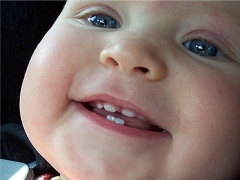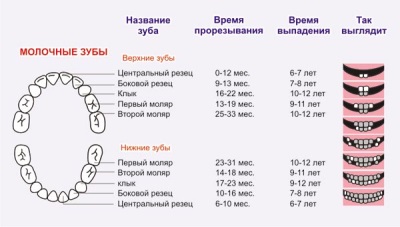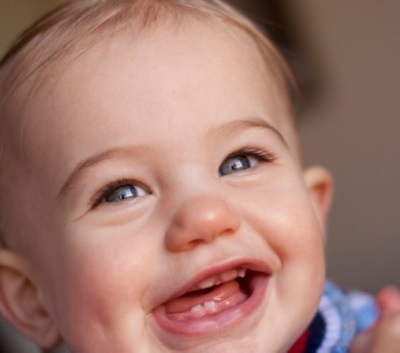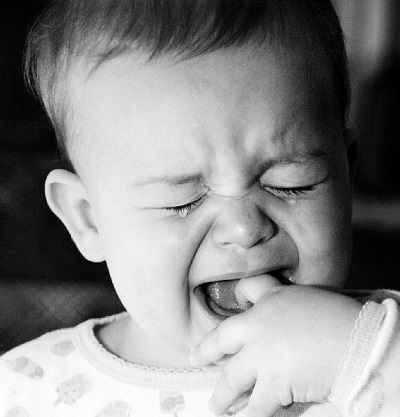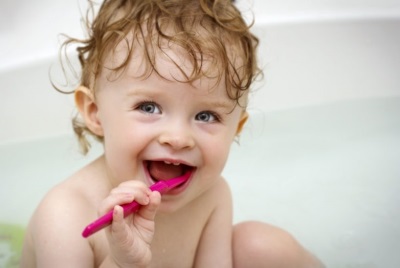The child fangs climb: symptoms
The appearance of milk teeth often causes discomfort and poor health in a child. Especially often the pain and pronounced symptoms of malaise accompany the eruption of the canines. What kind of teeth do they have when they are cut by the kids and how can they help the little one cope with the unpleasant sensations from this process?
Where are you located?
The arrangement of the canines in the dentition allows us to call such teeth "threes", since they cut between the lateral incisors (second teeth, if you count from the center of the dentition) and the first molars (fourth teeth).
The timing of the appearance of canines
Usually, by the time it comes to teething, the child already has 12 teeth. It is about the incisors (there are eight of them - 4 central and 4 lateral), as well as the first molars.
Normally, teething begins at the age of 16-18 months. It is then that the fangs of most healthy babies begin to climb. If it is more precise, then the average term of “pecking” of the upper canines is called age from 16 to 22 months, and the lower canines climb at the age of a child from 17 to 23 months.
As for changing these teeth to permanent ones, loss of milk canines is most often observed in children whose age is 9-12 years. Permanent canines begin to cut from 9-10 years. In this case, the lower canines are first cut, and a little later (at the age of 11-12 years old), a pair of canines appears on the upper jaw.
What symptoms indicate that fangs are being cut?
Signs of the upcoming appearance of canines occur in babies long before the moment when these teeth appear from the gums. Usually, the symptoms of their appearance are experienced 2-4 weeks before teething., but there are often situations when fangs start to bother the little one even earlier.
A child with cutting fangs parents will notice:
- Bad mood, irritability and moods.
- Copious salivationwhich can provoke cough or runny nose.
- Swollen and discolored gums in places where canine is expected. They turn red and become more relief, after which a new tooth appears as a white dot under the gum.
- Reduced appetite and sometimes refusal to eat.
- Restless sleepprevented by pain and burning in the gums.
- The desire to gnaw and gnaw different objectsso that they scratched gums.
The pediatrician of the highest category, Mikhailova TM, tells in detail about the symptoms.
Such symptoms are observed in many babies, but when teething fangs, they are often joined by more unpleasant symptoms, including:
- Temperature rise to + 37.5 + 38 ° С (less often up to +39 ° C) within 1-3 days.
- Liquefied chaircaused by excess saliva swallowed by a toddler.
- Strengthening the gag reflex, which is also associated with a large amount of saliva in the mouth of the toddler.
- Chin Rash due to irritant effects of saliva.
Is it true that teething is the most painful?
The appearance of canines is indeed the most difficult and uncomfortable process for children, which is associated with the anatomical features and location of these teeth. Their roots are quite long and deep in the gums.In addition, the upper canines are located near the junction of the facial nerves, because of what they are called "eye" teeth. When teething of this pair of teeth, in addition to the usual characteristic symptoms, a child may develop tearing and other signs of conjunctivitis.
The eruption of the canines in the lower jaw is not so painful, therefore, such teeth bother babies less, but parents should be prepared for a temperature rise of up to 3 days, and for a short-term breakdown of the stool, and for other "dental" symptoms that worsen the mood and mood of the peanut .
How to help the baby?
Since the cutting fangs in many babies cause discomfort, the task of parents should be to support the children in such a difficult period and to surround them with care. To make children overcome the process of the appearance of canines easier, you can:
- Offer the child to nibble toys specially designed for this purpose.called teethers. Inside they are filled with gel or water. Placing such a toy in the refrigerator for a while, the mother will help cool the gums and eliminate their itching. You can also give the baby nibble on the bottle and special orthodontic pacifiers.
- Use pharmaceutical drugs in the form of gels that have an anesthetic and anti-inflammatory effect. These include Dentinox, Kamistad, Dantinorm Baby, Calgel, Baby doctor First teeth and other similar means. It is only important to remember that before using any gel from the children listed above, it is necessary to consult a pediatrician.
- When the temperature rises above + 38 ° C and consultations with a pediatrician, the child is given a febrifuge. Drugs of choice in childhood are drugs containing paracetamol. An alternative option is considered drugs that contain ibuprofen. Both drugs are safe even in infancy and effectively eliminate fever. At the same time, they are presented in several forms, among which candles and syrups are most relevant for children in their first years of life. The effect of the syrup is faster, but also shorter, and the candles, though they do not immediately reduce the temperature, but have an effect for a longer period.
How to prevent dental problems
Any mother wants her baby's teeth to be strong and durable, but care should be started long before the eruption of permanent teeth. If more precisely, then you need to start caring for children's teeth even during pregnancy, when they are laid at the fetus. The more attentive the mother is to the way of life and her nutrition, the less problems with the teeth will be in the child both in the first years of life, when baby teeth appear, and in adulthood.
Pregnant women should eat enough dairy products, fish and seafood, and take calcium complexes on the advice of a gynecologist. This macronutrient is necessary for the baby to form the rudiments of the teeth, and if there is a shortage in the diet of the future mother, it can cause dental problems in the baby.
After giving birth, for normal development of the teeth, babies need good nutrition, the best option of which is considered breast milk. In this case, the nursing mother must certainly eat a balanced diet. When it is impossible to breastfeed, the baby is given a high-quality mixture containing all the elements for the growth of teeth.
So that the health of both dairy and permanent fangs is strong, one should not acquaint the child with sweets too early. Candy and chocolate should be left until 3 years or later. In addition, it is necessary to limit the use of juices, because they have a fairly high sugar content. Especially dangerous for the strength of canines to give a sweet drink before bedtime.
It is important to maintain the health of canines and daily hygiene.While the teeth are still being cut, they can be cleaned with a silicone fingertip or a gauze tampon, and the older toddler get a suitable age brush and paste.
You will learn a lot of other useful information by looking at Dr. Komarovsky’s program.
